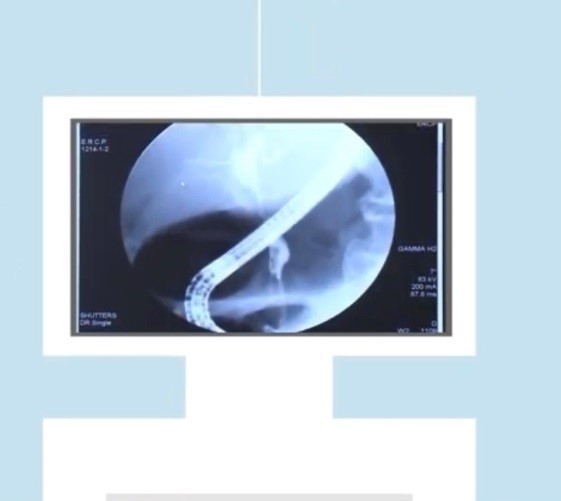What is ERCP?
ERCP is performed by using a duodenoscope. The scope is inserted through esophagus to the stomach and into the second portion of duodenum. Once the papilla of Vater is identified, the bile ducts and pancreatic ducts are injected with contrast material through a small plastic catheter, and x-ray pictures are taken. When these x-ray pictures show stones, obstructions or other pancreatico-biliary diseases, they can often be treated during the same ERCP examination.
What preparation is required?
- Please read the consent form and providing clear description of complications of ERCP before the examination.
- Blood test or other imaging studies will be done.
- You will be starved 8 hours before the procedure, including water and medicine. If you feel thirsty, you can use water to rinse your mouth to reduce discomfort.
- On the procedure day, please pay attention to your oral hygiene and change to the surgical gown.
- Please remove your denture, eyeglasses, watch, underwire bra, and also urinate before your entering to the examination room.
- We will insert an intravenous catheter into a vein in your right hand, and sedatives or any necessary medications will be given.
- There will be an assistant using wheelchair or moving bed to send you to the ERCP room which is located on the 2nd floor of the Children Hospital.
- If you are scheduled through the outpatient clinic, please proceed to the ERCP room directly which is located on the 2nd floor of the Children Hospital.
- Having undergone abdominal surgery, especially stomach and pancreatic surgeries will greatly increase the difficulty of the examination and the risk of complications. Please inform the doctor in detail about your previous surgical history.
- If you have drug allergies, use anticoagulants or platelet inhibitors, glaucoma, prostate hypertrophy, heart disease, arrhythmia, have artificial valves, artificial blood vessels, cardiac rhythm regulators, pregnancy, AIDS or other infectious diseases , please report to your doctor first.


During an ERCP
- The technician will inject antispasmodic to you, and this medication helps to decrease your saliva, gastric acid, and bowel movement.
- The technician will spray a local anesthetic in your throat, this could allow the endoscopic tube pass your throat smoothly and reduce your discomfort.
- Please remove any tight clothes and relax during the procedure. Please remove your Eyeglasses and denture, and lose your clothes.
- Please lie on the examination table then turn to your left side. Doctor will insert the endoscopic tube through your mouth and inject the dye to show your biliary and pancreatic duct on the X-ray film.
- If you experience nausea and vomiting during the procedure, this is a normal reaction due to the procedure. Take a deep breath and relax to reduce the discomfort and allow the procedure proceed smoothly. We will add some medication into your infusion to reduce your discomfort.
- The total procedure usually takes approximately 20-30 minutes. If there is a stone or narrowing of the duct noticed, the doctor can widen the opening of the papilla to remove the stone or put a stent to drain the bile.
- You have a bile duct stent and a pancreatic duct stent built into your body on the - - (yyyy-mm-dd). Please return regularly for follow-up evaluation for removal or replacement.
After an ERCP
- You can try to drink a little water about one hour after the procedure to see if your swallow function has recovered. If you can drink without chocking, this means the swallow function has recovered.
- Please follow your doctor’s instruction about when you can start to eat.
- If you experience sore throat, you can use a little mouth wash to gargle.
- If you experience tachycardia, chest tightness, difficulty in swallowing, abdominal pain, dry mouth, difficult voiding, fever, or black stool, please inform your health care provider immediately
- Due to the medicine given during the procedure, you may feel sleepy, please watch your own steps to prevent fall. If you have ERCP as outpatient, do not drive or operate any machinery right after the procedure
- For outpatient, please come back to see your report a few days after the procedure
Risk and complications
Although complications can occur, they are uncommon. Complications can include pancreatitis (1-18%), bleeding (2.0%), cholangitis (1.0%), cholecystitis (0.5%) and bowel perforation (0.3%)

